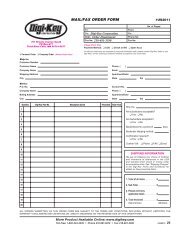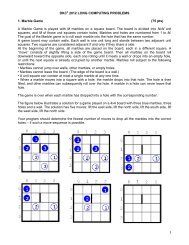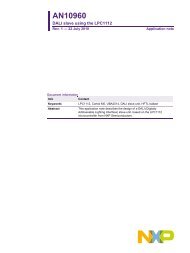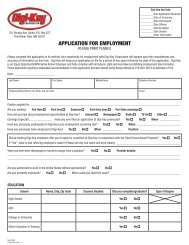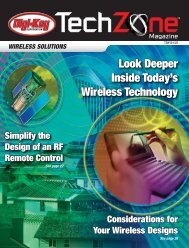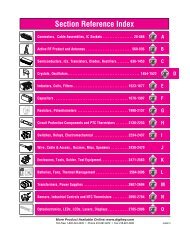Microcontroller Solutions TechZone Magazine, April 2011 - Digikey
Microcontroller Solutions TechZone Magazine, April 2011 - Digikey
Microcontroller Solutions TechZone Magazine, April 2011 - Digikey
You also want an ePaper? Increase the reach of your titles
YUMPU automatically turns print PDFs into web optimized ePapers that Google loves.
Power Debugging ARM Cortex-M3<br />
and Cortex-M4 Applications<br />
by Lotta Frimanson and Anders Lundgren, IAR Systems<br />
Your application is now working properly,<br />
but you’re still over your power budget.<br />
This article shows you how to debug that<br />
problem, too.<br />
Power debugging is a recent innovation that provides software<br />
developers with information about how the software implementation<br />
in an embedded system affects system-level power consumption. By<br />
coupling source code to power consumption, testing and tuning for<br />
power optimization is enabled.<br />
Long battery lifetime is a very important factor for many embedded<br />
systems in almost any market segment--medical, consumer<br />
electronics, home automation, and many more. Power consumption<br />
has traditionally been a design goal that only the hardware developers<br />
have been able to infl uence. But in an active system, power<br />
consumption depends not only on the design of the hardware but also<br />
how it is used, which in turn is controlled by the system software.<br />
The technology for power debugging is based on the ability to<br />
sample power consumption and correlate each sample with the<br />
program’s instruction sequence and hence with the source code.<br />
One diffi culty is achieving high precision sampling. It would be ideal<br />
to be able to sample power consumption with the same frequency<br />
the system clock uses, but power system capacitances reduce the<br />
reliability of such measurements. Usually this is not a problem since<br />
from the software developer’s perspective, it is more interesting<br />
to correlate the power consumption with the source code and<br />
various events in the program execution rather than with individual<br />
instructions, so the resolution needed is much lower than one<br />
sample per instruction.<br />
Typically within the debug probe, a resistor is connected in series with<br />
the supply to the development board. The voltage drop across this<br />
resistor is measured, fed to a differential amplifi er and then sampled<br />
by an A/D converter.<br />
The key to accurate power debugging is a good correlation between<br />
the instruction trace and the power samples. The best correlation can<br />
be achieved if a complete instruction trace is available, as is the case<br />
for ARM MCUs with ETM (Embedded Trace Macrocell) support. The<br />
drawback with using ETM is that it requires a special debug probe<br />
and ETM support in the device itself.<br />
Figure 1: The debug module on Cortex-M3/M4.<br />
Less accurate but still giving good correlation is to use the PC (Program<br />
Counter) sampling facility available in the ARM Cortex-M3/M4 cores<br />
(Figure 1). The DWT (Discrete Wavelet Transform) module implements<br />
the PC sampler; it samples the PC periodically around 10,000 times per<br />
second and triggers an ITM (Instrumentation Trace Macrocell) packet for<br />
each sample taken. The ITM is the formatter for events originating from<br />
the DWT. It packetizes the events and timestamps them. The debug<br />
probe (J-Link Ultra) samples the power consumption of the device using<br />
an A/D converter. By time stamping the sampled power values and the<br />
PC samples, the debugger is able to present power data on the same<br />
time axis as graphs like the interrupt log and variable plots as well as to<br />
correlate power data with the source code.<br />
As stated before, power debugging is based on the ability to sample<br />
the power consumption and correlate each sample with the source<br />
code. For example, in IAR Embedded Workbench the power samples<br />
can be displayed in different formats. The Power Log window (Figure<br />
2) is a log of all collected power samples. This window can be useful<br />
to fi nd peaks in the power sampling, and since the power samples are<br />
correlated with the executed code it is possible to double-click on a<br />
value in the Power Log window and get to the corresponding code.<br />
Figure 2: Power Log window.<br />
58



